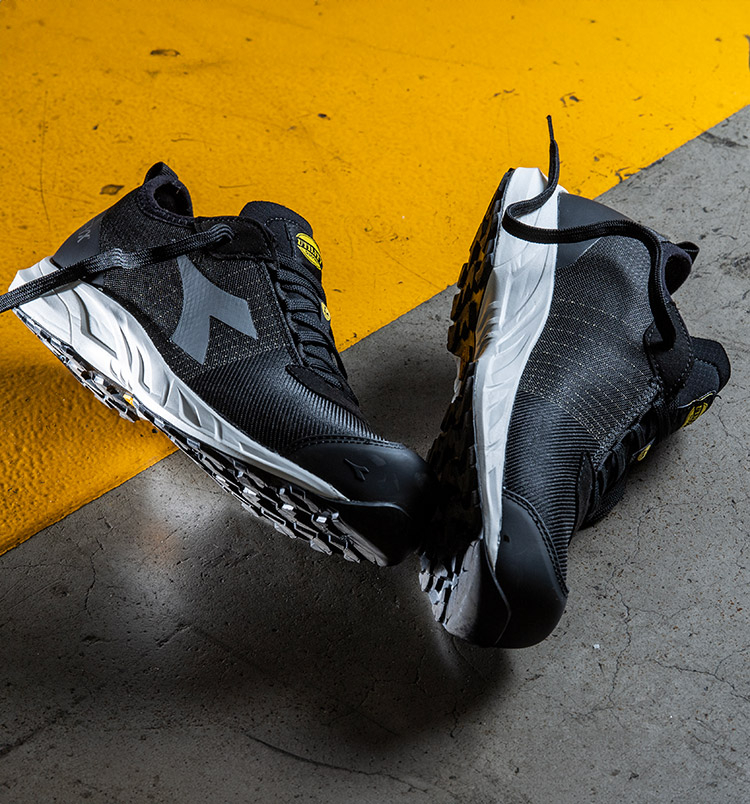Utility Fly Work Boots and Safety Shoes
(6 Results)


FLY MOTOR MATRYX LOW S3L FO SR HRO SC ESD - Low safety shoe - Diadora Utility x Ducati Corse


FLY MOTOR MATRYX LOW S1PL SR HRO SR SC ESD - Low safety shoe - Diadora Utility x Ducati Corse


FLY LITEBASE MATRYX BOA LOW S3L FO SR HRO SC ESD - Low safety shoe with BOA Fit micro-metric lacing system
The Lightest Safety Shoes
Are there safety shoes as light and comfortable as running shoes?
How much does a safety shoe weigh? On average, a safety shoe weighs around 500 grams – but let’s clarify that this is a general value and doesn’t take into account the wide variety of models and uses for work shoes.
The weight of a work shoe depends on its size, model, materials, design, and the technologies used. A common misconception is that safety shoes are much heavier than regular sports or casual shoes.
This idea has some basis: safety shoes need to protect during work, and sturdiness is a fundamental requirement. Qualities like construction solidity, tear-resistant and abrasion-resistant materials contribute to increased weight.
However, things have changed thanks to significant advancements in the research and development of design, materials, and construction techniques, allowing the creation of safety shoes as light as sports shoes without compromising safety.
Why use lightweight safety shoes?
Wearing lightweight safety shoes allows for greater comfort, agile movement, and reduced fatigue by the end of the day, significantly improving thermal comfort inside the shoe, especially for tasks requiring long periods of walking or driving.
Reducing the shoe's weight positively impacts the overall well-being of the foot, leg, and correct posture, helping to end the day without foot pain or backache.
A low and lightweight safety shoe is a practical, high-performance, and versatile choice, particularly for sectors like logistics, plant engineering, craftsmanship, industry, and workshops, where work is mostly indoors and on surfaces that don’t require a high upper for ankle support.
A Safety Shoe as Light as a Running Shoe
So, what are the lightest work shoes available?
If you’re looking for a lightweight safety shoe, Fly Litebase is exceptional, the most innovative among Diadora Utility’s new offerings.
Fly weighs around 350 grams, like a running shoe – in fact, it weighs even less than many sports shoes – but it maintains the high safety and performance standards of Diadora Utility’s protective footwear.
The lightness and comfort of the Fly models, available in safety classes S1P and S3, were unimaginable not long ago and are the result of careful design of the components and materials, as well as the collaboration between Diadora Utility and Vibram, the leading brand in the development and production of high-performance rubber soles.
Let’s detail the features that make Fly Litebase S1P and S3 shoes so light and innovative.
1. The Upper
The upper affects the overall weight of the shoe both in design and material. Technical fabrics like microfibers are the lightest materials for constructing a work shoe upper. Fly’s upper is made of Matryx® 2.0, a high-tenacity, high-performance technical fabric designed to be lightweight and flexible while offering maximum abrasion resistance.
2. The Protective Toe Cap
The protective toe cap significantly impacts the weight of a safety shoe: the heaviest are made of steel, while the lightest are made of carbon fiber – just like the Fly line shoes, which feature a 200 J crush-resistant, lightweight, non-magnetic, and non-thermal carbon fiber toe cap.
3. The Anti-Puncture Insert
Fly Litebase is available in safety classes S1P and S3, meaning all models come with an anti-puncture plate to protect against risks like stepping on nails or other sharp objects that could pierce the sole. Fly’s anti-puncture insert is made of recycled polyethylene agglomerate, a lightweight, flexible, and breathable material.
4. The Lining
Just like the external material of the upper, the Air Mesh lining and microfiber heel counter of Fly Litebase shoes contribute to reducing the overall weight of the shoe.
5. The Midsole and Outsole
The true strengths of Fly are the EVA midsole with TPU protective film and the HRO nitrile rubber outsole from Vibram®.
In the overall weight of the shoe, the midsole plays a crucial role: volumetrically, it weighs more than the rubber outsole, and even small density differences can significantly impact weight. Thanks to the EVA midsole with TPU protective film, Fly Litebase safety shoes combine lightness and safety.
Additionally, the weight of the HRO nitrile rubber outsole from Vibram® has been drastically reduced thanks to the innovative Vibram Litebase sole technology, which reduces thickness and weight without compromising high performance in terms of grip, traction, and wear resistance.
The thickness of the Vibram Litebase rubber sole is 50% thinner than a regular sole and weighs up to 30% less. Having a thinner sole does not compromise safety or shoe durability, as the outsole is designed to maximize grip, stability, and durability, thanks to the large contact area and reinforced lugs.
All Fly Litebase models are ESD and SRC (to learn more about additional safety shoe requirements, click here), meaning their sole meets the highest level of slip resistance (SRC) and aids in dissipating current (ESC), protecting valuable equipment even in sterile environments.








